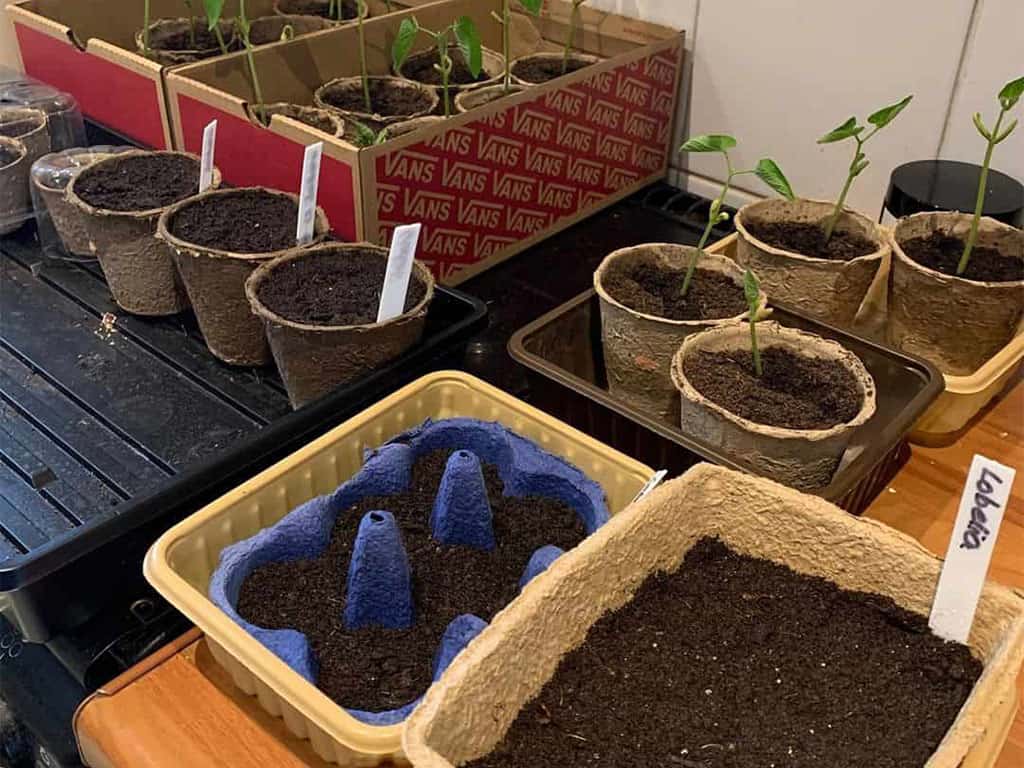When you’re living in a city, outdoor space is generally at a premium. If you’re lucky, you’ll have a roof terrace, courtyard or balcony. More likely, you’ll have a doorstep or Juliet balcony. So, how can you grow greenery when there’s barely any space for a plant pot? The answer is to look for a new angle – quite literally – and start employing vertical, green wall ideas.
If you don’t have any outdoor access at all, check out our posts on indoor gardens and kitchen herb gardens!
What are green walls?
Green walls, also called “living walls” or “vertical gardens” are where you have living plants growing from a vertical surface – like a wall, or fence – instead of on the floor. You’ll find them in lots of edgy, modern landscaping, and they’re an interesting way to add plants to a space that doesn’t have room for conventional plant options (like a lawn). In many ways, they’re very similar to green roofs.
There are a few tricks and systems to getting plants to grow like this, which we’ll look at in this post.
What are the benefits of green walls?

As you’ll see in the list of green wall ideas coming up, plants are an excellent way to make otherwise bare walls or fences more interesting. You can use them to create privacy, to break up a visually monotonous surface, or to disguise uninspiring garden sheds and storage units. Wherever you position them, green walls make a garden look more vibrant and welcoming.
There are also environmental benefits to having a green wall. As with any patch of plants, living walls will capture carbon dioxide and airborne particles, helping you breathe a little easier. A large section of green wall can actually help to reduce the ambient temperature nearby, too. Plus, the plants growing on your vertical garden provide food and shelter for insects and wildlife.
Your building might even thank you! Depending on where you place it, the plants on your living wall will absorb a significant amount of rain, protecting your building and limiting the amount of runoff clogging your drains. Your plants will also act as insulation – both for the noise coming in off the street, and for the temperature inside your home (hello, lower heating bills)!
Finally, a living wall will allow you to flex your green thumb in urban areas that would normally make growing things tricky – like patios, roof gardens, stairwells and terraces. Only certain plants will thrive in a green wall, so finding the right combination can be a fun challenge.
What are the drawbacks of green walls?
There are a couple of challenges when it comes to cultivating green walls. For example, when you’re setting up your green wall, it’s really important to get the waterproofing right. If you don’t, you can end up with moisture damage, or with plant roots breaking through the barriers and reaching your walls.
Vertical landscaping generally needs more planning and maintenance than conventional gardens, too. This is mostly to ensure your plants are getting the right amount of water, and aren’t dehydrated or water-logged.
How do you create a green wall?

via ikea.co.uk
Much like a green roof, there are several ways to make a living wall. They’re generally known as: direct greening, indirect greening and living wall systems. The type of green wall method you choose will probably depend on:
- If you have a specific “look” in mind
- Your budget
- The area you’re aiming to cover
- Whether there’s a surface beneath the wall you can use
- How much maintenance you’re prepared for
Green Wall Ideas: Direct Greening
Direct greening is where you allow a naturally self-climbing plant to use the wall for support. For example, ivy that covers the façade of a house – the climbing roots are directly attached to the building. You could also plant wall-clinging shrubs or, you can train certain fruit trees into espaliers or fans.
The effect can be visually stunning, but structurally devastating for the supporting walls. So, if you choose this method, make sure you fully understand how to manage the plants you choose and the potential risks. Direct greening is relatively low-cost, but you’ll need patience and some DIY skills.
Green Wall Ideas: Indirect Greening

If you want to prevent your living wall from embedding itself into your home or garden building, indirect greening is the method you need. This is where you use a trellis, wire frame or twine structure for your plants to climb, but deliberately leave a small gap between the vegetation and the building.
Depending on how it’s set up, this can create a “green curtain” effect, rather than a “green wall”. That’s not necessarily a bad thing – green curtains or canopies look beautiful and provide shade and privacy.
Indirect greening is relatively straightforward, both in terms of the materials you need and the level of skill needed for setup. If you’re trying to install on a large scale, consider seeking professional expertise about the size of the trellis and the potential weight of the plants.
You can also use wall-mounted baskets to create the green wall effect. Hanging baskets are great for adding structure, colour and depth to even the smallest garden space. Take a look at our hanging basket tips for how to grow the best displays each season.
Green Wall Ideas: Living Wall Systems
A “living wall system” is what most people think of when they picture a lush green wall. Living wall systems use panels or containers of growing media to house plants without touching the ground at all. However, these systems need the highest level of care, and may need the kind of professional irrigation system we mentioned earlier.
Living wall systems are generally the most visually interesting green walls, thanks to the diversity of plants that can live in them. Succulents, grasses, sedums, ferns and moss are all popular candidates.
Although living wall systems can be complex, their popularity means that there are entry-level options available too. Look for grow-bag starter kits and specially-designed felt matting at garden centres, along with plugs (rather than seedlings) to get your plants going.
Green Wall Ideas: What to Plant
The type of green wall ideas you choose will have a big impact on the most appropriate plants. You’ll also need to look at the specific wall you’re using, and measure the ambient humidity levels as well as how much sun/shade it gets during the day. When you’re picking plants, look for ones that have similar light and watering requirements to each other.
Shrubs are good, hardy base plants to start your green wall. Climbers are great for adding texture (non-flowering ones will look great year-round, while flowering ones will give you an extra-stunning view and fragrance in summer).
Closely-packed pots of bushy flowers can create the effect of a living wall if you gently tilt them. Wildflowers look beautiful, or you could dry different-coloured varieties of begonias, marigolds or busy lizzies.
Sedums are a popular choice for green walls and green roofs, as they’re incredibly tolerant to even the worst of British weather. Many garden centres actually stock sedum “mats”, with pre-grown plants that can provide instant coverage.
For show-stopping texture, look for ornamental grasses and sedges that really bring a green wall to life. They’ll sway in the wind and make your walls look incredibly touchable!
As I mentioned in our post on herb gardens, perennial herbs are incredibly flexible in their living arrangements. Mint, thyme and rosemary are particularly easy to grow – plus they smell great and can be harvested for use in the kitchen, too!
Is there anything more rewarding than growing your own food at home? Lots of fruits and vegetables will happily grow in pots outside in the UK, and you can slowly cultivate a green wall that has both style and substance.
Some green wall ideas focus on moss or lichen. These understated designs have incredible texture, and look more like a living painting than a regular green wall. Moss needs a good amount of moisture to thrive, so if your garden struggles with moisture, this could be a good choice.
Of course… For maximum impact with minimum hassle, you could always just fake it. Lots of homeware stores sell bushy panels made from artificial leaves and stems, giving you the green wall look without the effort of growing and maintaining one.

From ikea.co.uk
Green walls are all about creativity and innovation. There aren’t rules as such, and you can use vertical garden ideas in all kinds of way to create upward greenery.
Which green wall ideas do you think look best? Would you try growing a green wall or green roof in your garden?

Save this pin for later













